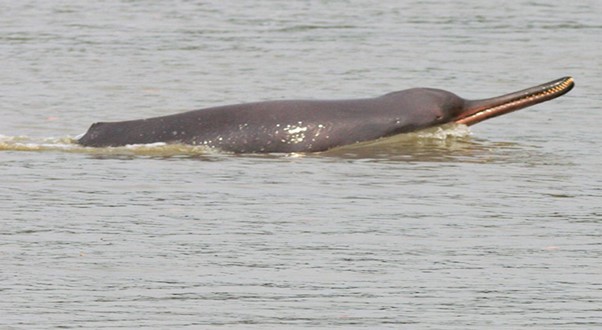- Courses
- GS Full Course 1 Year
- GS Full Course 2 Year
- GS Full Course 3 Year
- GS Full Course Till Selection
- Answer Alpha: Mains 2025 Mentorship
- MEP (Mains Enrichment Programme) Data, Facts
- Essay Target – 150+ Marks
- Online Program
- GS Recorded Course
- Polity
- Geography
- Economy
- Ancient, Medieval and Art & Culture AMAC
- Modern India, Post Independence & World History
- Environment
- Governance
- Science & Technology
- International Relations and Internal Security
- Disaster Management
- Ethics
- NCERT Current Affairs
- Indian Society and Social Issue
- NCERT- Science and Technology
- NCERT - Geography
- NCERT - Ancient History
- NCERT- World History
- NCERT Modern History
- CSAT
- 5 LAYERED ARJUNA Mentorship
- Public Administration Optional
- ABOUT US
- OUR TOPPERS
- TEST SERIES
- FREE STUDY MATERIAL
- VIDEOS
- CONTACT US
Ganges River Dolphin
Ganges River Dolphin
10-10-2023

Latest Context:
Recently, a scientific study titled "Rescuing Ganges river dolphins from irrigation canals in Uttar Pradesh, 2013-2020" was released.
Key highlights of the report are:
- Habitat destruction: Dams and barrages have badly affected the habitat of the Gangetic dolphins, forcing them to go into irrigation canals where they are at risk of injury or even death.
- Seasons: Around 70% of entrapments were reported either post-monsoon or during peak winter season, while the other 30% of dolphins were rescued during peak summer season, when water levels fall and the minimum water flow is maintained.
- Rescue: Almost 19 dolphins were rescued from irrigation canals in the Ganga-Ghagra basin in Uttar Pradesh between the year 2013-2020.
About Ganges River Dolphin
- Scientific Name: Scientifically known as Platanista gangetica. They are also known as the “Tiger of the Ganges” and was officially discovered in 1801. They are the National Aquatic Animal of India and also the State Aquatic Animal of Assam.
- Size: Adult Ganges River Dolphins typically measure between 1.8 to 2.6 meters (6 to 8.5 feet) in length.
- Colour: They are typically grayish to brown in colour and have a rounded forehead without a distinct beak, which sets them apart from oceanic dolphins.
- Eyes: Their eyes lack a crystalline lens, making them essentially blind.
- Habitat: They are primarily found in the freshwater river systems of South Asia, with the largest populations in the Ganges and Brahmaputra rivers in India, Nepal, and Bangladesh. They tend to inhabit deep pools and confluence zones where water is slow-moving, as these areas are rich in prey.
- Behaviour and Diet: These dolphins use echolocation to navigate, communicate, and locate prey. They emit high-pitched sounds, which bounce off objects in their environment and return as echoes, allowing them to "see" in their murky river habitats. Being a mammal, they cannot breathe inside the water and need to come to surface every 30 to 120 seconds and because of the sound it produces while breathing, they are popularly known as 'Susu'. Their diet mainly consists of fish and crustaceans, such as catfish and carp.
- Threats: The primary threats include water pollution from industrial and agricultural sources, unintentional killing through entanglement in fishing gear, poaching for dolphin oil and the construction of dams and irrigation projects, which disrupt their habitat.
- Protection Status:
- Wildlife (Protection) Act 1972: Schedule I
- CITES: Appendix I
- IUCN: Endangered
- Convention on Migratory Species (CMS): Appendix 1
- Cultural Significance: In some cultures of South Asia, they are considered a sacred and revered species. Their presence in the Ganges River is seen as a positive sign and is associated with the mythology and spirituality of the region.
Initiatives taken by India to protect Ganges River Dolphin
- Declaration of Protected Areas: The government has established protected areas and sanctuaries along the Ganges and its tributaries to conserve the Ganges River Dolphin and its habitat. For example, the Vikramshila Gangetic Dolphin Sanctuary in Bihar.
- Education and Awareness: Various programs and initiatives were launched like Project Dolphin to raise awareness about the importance of it among the local communities, students, and the general public. October 5 is celebrated as the ‘National Ganga River Dolphin Day’.
- Regulation of Fisheries: The government has put in place regulations to control and monitor fishing practices in areas inhabited by them. This includes restrictions on the use of certain types of fishing gear that can harm dolphins.
- International Collaboration: India has collaborated with neighbouring countries like Nepal and Bangladesh to ensure the transboundary conservation of the Ganges River Dolphin, as these dolphins often traverse international borders in their range.



